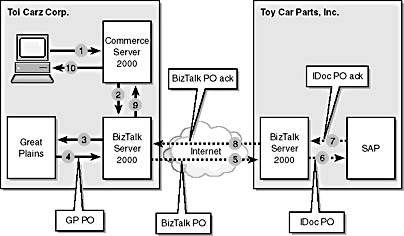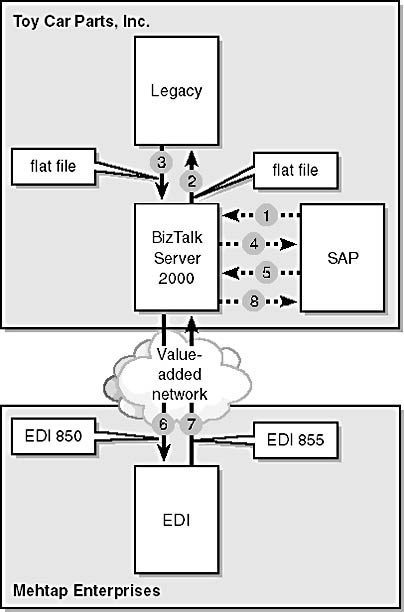BizTalk Server 2000 Data Processing
BizTalk Server 2000 can do much more than move XML documents around the Internet. The product is designed to be a centerpiece for managing agreements between you and your trading partners. It does this by providing a rich set of tools for creating descriptions of your partnership arrangements.
In the following scenario, let's see how a BizTalk server can be used to integrate an order process between three companies. A description of the players follows.
- Toi Carz Corp. is a manufacturer that produces toy cars. Toi Carz is running Microsoft Commerce Server 2000 to manage its Internet presence. It is using Great Plains software as its accounting system. It is running BizTalk Server 2000 to manage its trading partner relationships.
- Toy Car Parts, Inc. is a distributor and importer of parts for toy cars and is one of Toi Carz' vendors. Because of acquisitions over the years, Toy Car Parts has an extensive set of legacy applications, some of which have been in use for decades. It is running an SAP R/3 system to manage its enterprise resource planning (ERP) environment. It is also running BizTalk Server 2000 to manage its trading partner relationships.
- Mehtap Enterprises is a manufacturer of motors for toy cars. Mehtap Enterprises is one of the manufacturers handled by Toy Car Parts, Inc. Mehtap Enterprises is an old brick-and-mortar manufacturer that installed an EDI system in the 1980s and hasn't upgraded since then. In order to deal with Mehtap Enterprises, we must be able to create and read certain EDI documents.
Placing an Order
In this example, an employee of Toi Carz will place an order for 10 Mehtap Enterprises engines. Its distributor, Toy Car Parts, Inc., has some inventory of these parts. The transaction is illustrated in Figure 12-9 and described in Table 12-1.
Table 12-1. A description of Figure 12-9, which illustrates the flow of data between two companies using BizTalk servers.
| Figure Step | Description |
|---|---|
| 1 | An employee of Toi Carz places an order for products. The order is processed by Commerce Server 2000. |
| 2 | Commerce Server sends a request to BizTalk Server 2000. |
| 3 | BizTalk Server 2000 sends a message to the Great Plains accounting system,… |
| 4 | …which generates a purchase order in Great Plains format and sends it to BizTalk Server 2000. |
| 5 | BizTalk Server 2000 translates the Great Plains purchase order into a BizTalk document and sends the document to the BizTalk server at Toy Car Parts over the Internet using HTTP. |
| 6 | Toy Car Parts uses SAP R/3. R/3 requires documents in IDoc format. BizTalk Server 2000 translates the BizTalk message into IDoc purchase order format and sends it to the SAP system. |
| 7 | The SAP system responds with an IDoc purchase order acknowledgment, which it sends back to the BizTalk server. |
| 8 | The Toy Car Parts BizTalk server transforms the acknowledgment into a BizTalk document and sends the document back to the Toi Carz BizTalk server. |
| 9 | The Toi Carz BizTalk server sends an acknowledgment (ack) over an internal system to Commerce Server 2000. |
| 10 | Commerce Server 2000 notifies the requestor that the distributor has received the order and that the distributor is currently processing the order. |

Figure 12-9. Placing an order with a distributor.
Checking Inventory and Ordering from the Manufacturer
Toy Car Parts needs to see if it has enough in stock to fulfill the order. Figure 12-10 shows how Toy Car Parts communicates with its suppliers. Table 12-2 describes the steps in Figure 12-10.

Figure 12-10. Communication between the distributor and manufacturer.
Table 12-2. A description of Figure 12-10.
| Figure Step | Description |
|---|---|
| 1 | The SAP system sends a request as an IDoc document to BizTalk Server 2000, asking the BizTalk server to request an inventory amount from the legacy inventory system. |
| 2 | BizTalk Server 2000 converts this IDoc file into a flat file, which is used to communicate with the legacy inventory system. It is important to note here that the SAP system doesn't "speak" flat file format, and the inventory system doesn't speak IDoc. BizTalk Server 2000 is providing the mapping between the two. |
| 3 | The legacy inventory system reports that only three parts are in stock. |
| 4 | Again, BizTalk Server 2000 translates the response, sending an IDoc document to the SAP system. |
| 5 | The SAP system knows that the request was for 10 units and knows that three are currently in stock, so it adjusts the order and creates an IDoc order for seven units. This order is sent to BizTalk Server 2000. |
| 6 | Since the manufacturer requires an EDI 850 order document, BizTalk Server 2000 converts the SAP IDoc request into an EDI 850 document and sends it over the value-added network, where the manufacturer, Mehtap Enterprises, is connected. |
| 7 | The EDI-based system at Mehtap Enterprises processes the request and sends back a response, as an EDI 855 Acknowledgment document. It is the job of the Mehtap Enterprises system to do whatever is necessary to fulfill the order. This is probably not an issue, since Mehtap Enterprises has been receiving orders as EDI 850 documents for decades. Mehtap Enterprises has no idea that we are speaking BizTalk, because BizTalk Server 2000 is doing all the transformation. |
| 8 | BizTalk Server 2000 converts the EDI 850 Acknowledgment into an IDoc and sends it to the SAP system. |
Sending an Acknowledgment to the Requestor
The last step is to send an acknowledgment to Toi Carz to indicate that the order was placed and provide an approximate shipping date. This is done using an advance ship notice, or ASN. Figure 12-11 illustrates this process. Table 12-3 describes the steps illustrated in Figure 12-11.
You should take note of some important issues illustrated in this scenario. First, there is no need for any of the existing applications (in this case, Great Plains, SAP, legacy inventory, or manufacturer) to change the way they currently operate. The BizTalk server acts as a universal translator, reading requests from one place, interpreting those requests according to rules set up in the partnership agreement, and transforming them into the appropriate output.
Second, the Internet can be used to get transactions from one place to another. This means that any company that is hooked into the Internet can be part of our business, as long as we set up an agreement with it.
Third, value-added networks can be used instead of the Internet if those networks are already in place and working fine.

Figure 12-11. Sending an advance ship notice back to the requesting organization.
Table 12-3. Description of the steps in Figure 12-11.
| Figure Step | Description |
|---|---|
| 1 | The SAP system generates an ASN in IDoc format and sends it to BizTalk Server 2000. |
| 2 | BizTalk Server 2000 at Toy Car Parts converts this ASN into an XML document and sends it to the Toi Carz BizTalk server. |
| 3 | BizTalk Server 2000 at Toi Carz converts the XML document into an ASN that is compatible with the Great Plains software. From there, the Great Plains system is updated, and the Toi Carz personnel can query the database as they always have done. |
You should take note of some important issues illustrated in this scenario. First, there is no need for any of the existing applications (in this case, Great Plains, SAP, legacy inventory, or manufacturer) to change the way they currently operate. The BizTalk Server 2000 acts as a universal translator, reading requests from one place, interpreting those requests according to rules set up in the partnership agreement, and transforming them into the appropriate output.
Second, the Internet can be used to get transactions from one place to another. This means that any company that is hooked into the Internet can be part of our business, as long as we set up an agreement with it.
Third, value-added networks can be used instead of the Internet if those networks are already in place and working fine.
EAN: 2147483647
Pages: 150